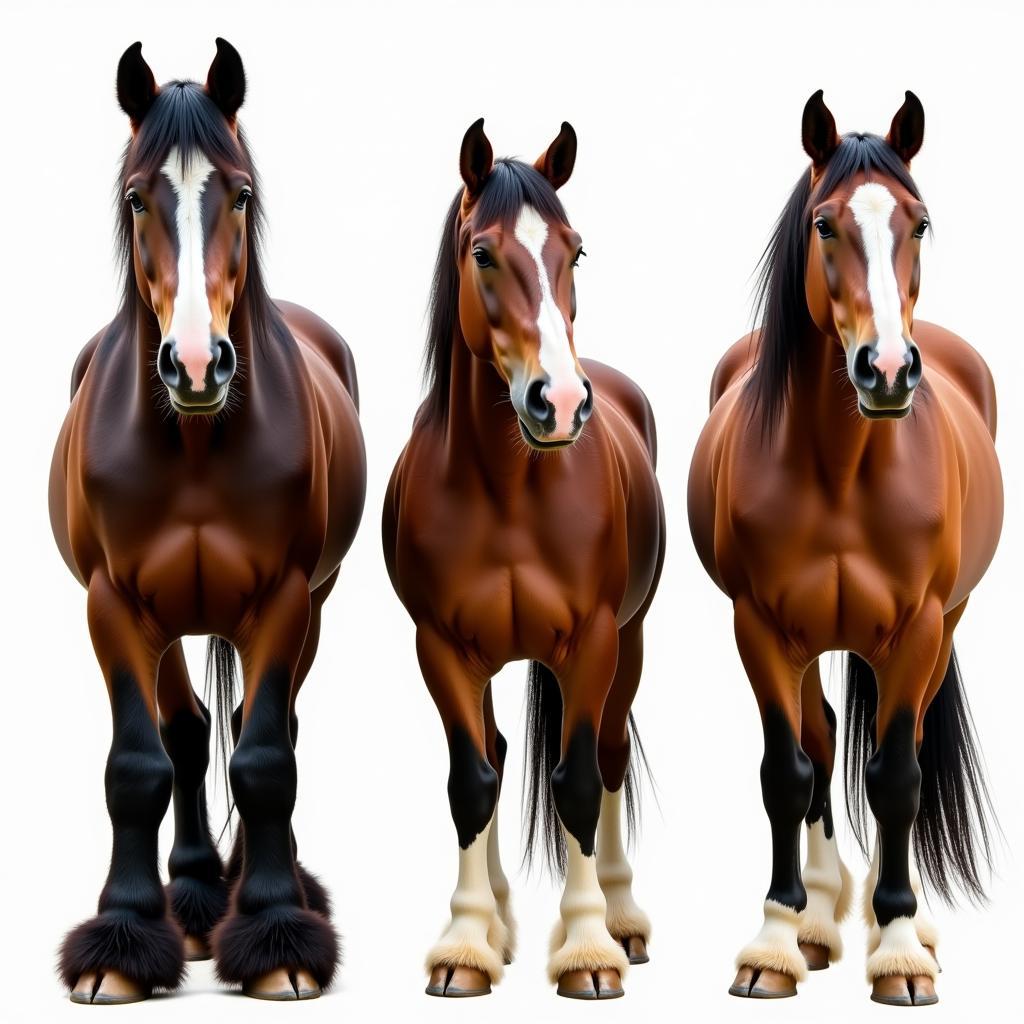Are Clydesdales The Biggest Horses? It’s a common question, and the answer isn’t as simple as you might think. While Clydesdales are undeniably impressive in size, their claim to being the “biggest” depends on how you define “biggest.” Let’s delve into the world of these gentle giants and explore their size in comparison to other horse breeds.
Defining “Biggest”: Height vs. Weight
When discussing horse size, we need to consider both height and weight. Clydesdales are famous for their towering stature, often reaching over 18 hands high. A “hand” is a unit of measurement equal to 4 inches, so an 18-hand horse stands at 6 feet tall at the withers (the highest point of the back). This certainly puts them in the running for tallest horse breeds. However, “biggest” can also refer to weight. Clydesdales are heavy horses, typically weighing between 1,800 and 2,300 pounds. But are there breeds that outweigh them?
A blue roan Clydesdale horse is particularly striking, but its size is generally consistent with other Clydesdales.
Comparing Clydesdales to Other Draft Breeds
Clydesdales belong to a category of horses called “draft horses,” known for their strength and size. Other draft breeds, such as Shires and Belgians, also boast impressive measurements. Shires, in particular, can sometimes surpass Clydesdales in height and weight, with some individuals reaching over 19 hands and weighing over 2,400 pounds. Belgians, while slightly shorter than Clydesdales, are often more heavily built and can have similar weights. So, while Clydesdales are among the largest horse breeds, they don’t always hold the absolute top spot.
What Horse is Bigger Than a Clydesdale? Exploring Shires and Belgians
So, what horse is bigger than a Clydesdale? As mentioned, Shires and Belgians are the main contenders. Shires are known for their massive feathered legs, adding to their overall imposing appearance. Belgians are often described as more compact and muscular than Clydesdales, giving them tremendous pulling power. While variations exist within each breed, it’s not uncommon to find Shires and Belgians that exceed the average Clydesdale in size.
 Clydesdale, Shire, and Belgian Horse Size Comparison
Clydesdale, Shire, and Belgian Horse Size Comparison
The Role of Genetics and Nutrition
Genetics play a significant role in determining a horse’s size. Just like humans, some horses are simply predisposed to be larger than others. Nutrition also plays a vital role. A balanced diet rich in essential nutrients is crucial for proper growth and development, especially during a horse’s formative years. A well-nourished Clydesdale, for instance, is more likely to reach its full size potential.
How Big Do Clydesdales Get? Factors Influencing Growth
How big do Clydesdales get? While genetics set the upper limit, several factors influence how close a Clydesdale comes to reaching its maximum size. These factors include proper nutrition, adequate exercise, and overall health. Neglecting any of these aspects can stunt growth and lead to a smaller adult size.
“Genetics are the foundation, but proper care and nutrition build the house,” says renowned equine specialist Dr. Amelia Hayes. “A Clydesdale with optimal care can truly reach its majestic potential.”
Beyond Size: The Gentle Giants’ Temperament
While their size is undeniably impressive, Clydesdales are equally known for their gentle and docile nature. They are often described as “gentle giants,” patient and tolerant, making them excellent family horses. Their calm demeanor and willingness to work have made them valuable partners in agriculture and transportation for centuries.
what horse is bigger than a clydesdale often involves comparing them to Shires.
Are Clydesdales Good Family Horses? Their Temperament and Trainability
Are Clydesdales good family horses? Their calm temperament and trainability make them suitable for experienced horse owners. However, their size requires careful handling and specialized equipment.
“Clydesdales possess an inherent gentleness that makes them wonderful companions,” shares experienced horse trainer, John Miller. “Their intelligence and willingness to please make them a joy to work with.”
Conclusion: Appreciating the Majesty of Clydesdales
Are Clydesdales the biggest horses? While they might not always hold the record for absolute height or weight, their impressive size, combined with their gentle nature, makes them truly majestic animals. Whether they’re the “biggest” or not is ultimately a matter of perspective. What’s undeniable is their enduring appeal and their well-deserved place among the giants of the equine world.
FAQ
- What is the average height of a Clydesdale? Around 16-18 hands.
- How much does a Clydesdale weigh? Typically between 1,800 and 2,300 pounds.
- Are Clydesdales easy to train? They are generally docile and willing to learn.
- What is the lifespan of a Clydesdale? Around 25-30 years.
- What are Clydesdales used for? Historically for draft work, now also for showing and pleasure riding.
- Are Clydesdales good for beginners? Their size requires experienced handling.
- What are the distinctive features of a Clydesdale? Large size, feathered legs, and often a bay coat with white markings.
When you need support, please contact us at Phone Number: 0772127271, Email: [email protected] or visit our address: QGM2+WX2, Vị Trung, Vị Thuỷ, Hậu Giang, Việt Nam. We have a 24/7 customer service team.